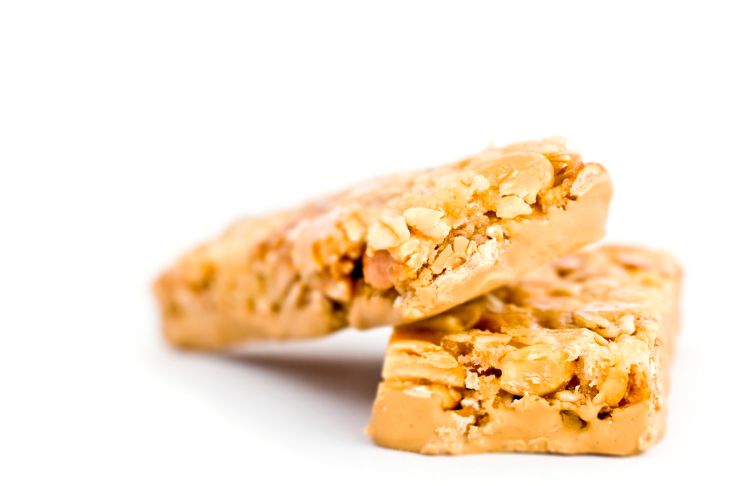Overcoming Plant Protein Challenges in Nutrition Bars
Manufacturers are formulating high-protein plant-based bars to deliver on taste, texture, and freshness.
Photo © iStockphoto.com/manley099

High-protein nutrition bars have come out of the gym and into the mainstream as more consumers seek to ensure that they meet their daily protein intake requirements and reap all the health benefits associated with protein. Although traditional protein sources frequently used in nutrition bar manufacturing, like dairy and soy, are still very much in demand, more bar manufacturers are also turning to plant-based protein, which presents its own set of unique formulating challenges.
Bart Child, senior vice president, commercial development, for contract manufacturer Nellson (Anaheim, CA), tells Nutritional Outlook while bar manufacturers have honed strategies for formulating with traditional protein sources like soy over the years, new plant proteins now require the same kind of development. Moreover, he points out, each plant source requires a slightly different manufacturing technique in order to maintain the protein’s functionality, as well as the bar’s intended flavor and texture. Here are some of the ways manufacturers in the nutrition bar space are working to advance plant protein’s bar capabilities.
Madelyn Faust, application specialist, bars and confectionery, DuPont Nutrition & Health (New Century, KS), says that the newest and most novel plant proteins often present the biggest manufacturing challenges. “These [novel plant proteins] range from brown rice protein to pumpkin seed protein. Many of these are lacking the basic functionality and protein quality compared to more established proteins, such as soy and dairy.” They often present off-notes and textural issues, as well. “While some proteins like rice tend to have a more neutral profile,” Child adds, “others like pea come with characteristic [flavor] notes that are more difficult to mask.”
Nevertheless, pea protein seems to be one of the frontrunners in plant-based bars, and for good reason: “In recent years, the processing technology of pea protein has improved drastically, resulting in enhanced functionality,” Faust says. DuPont’s TruPro 1614 pea crisp, for instance, is able to deliver 55% protein, a clean flavor profile, and a neutral color and flavor in bar applications.
Paige Ties, senior technical service specialist, research and development, Cargill (Minneapolis), says that the company’s pea protein, developed by Puris (Minneapolis), comes from a proprietary yellow pea variety “specially selected to minimize the off-flavors normally attributed to pulses.”
Another challenge for bar manufacturers is that some plant proteins are incomplete proteins because they lack the amino acids methionine and cysteine. Ties says this is a key area of concern for nutrition bar brands who want to use plant protein, because in order to make packaging claims about protein content, the protein must be calculated as a complete protein-meaning that all essential amino acids must be present in the protein. Ties says that nutrition bar formulators can compensate for these limiting amino acids by blending pea protein with another complementary protein source-for example, chickpea, soy, or pumpkin protein. “Blend the two ingredients together in the right ratio,” she says, “and formulators can take advantage of the functional benefits of pea protein, yet still make complete-protein claims.”
Another option for manufacturers hoping to hit protein-claim targets is to add additional plant protein, Ties says. But here, too, lies another potential pitfall: the more plant protein you add to a formulation, the greater the risk of flavor off-notes and gritty or dry texture. Nellson’s Child says that “increasing the protein content has significant effects on taste and texture.” He says that new and novel plant protein sources “for which the extraction and processing has not been optimized yet” are more likely to come with additional sensory baggage.
“Flavor characteristics from the [plant protein] source material may linger in the protein concentrate and become particularly strong at high usage levels,” Child says. “Likewise, newer sources that can only be extracted to a level of 20% or 40% protein (compared to upwards of 80% for dairy or soy) must be added in greater amounts to meet a particular target, often causing greater textural concerns such as dryness or grittiness.”
In addition, some plant proteins work better in one format of nutrition bar than another. Ties explains: “When incorporating a protein powder into the binder of a slab or extruded nutrition bar, it’s important to manage protein hydration to optimize the mouthfeel of the bar.” In these types of applications, she says, manufacturers may need to include a more functional protein in the oil or water portions of the bar. If the nutrition bar is in a crisp-type format, however, “the water and protein interactions are of a different concern, because proteins tend to hydrate and compete for water,” thus, increasing the density of the crisp.
One solution Ties offers in formulating plant proteins in these types of high-protein applications is to add the protein throughout the components of the bar, including in the binder, compound coating, and crisps. “By doing this, you mitigate some of the taste or textural concerns often associated with higher protein levels.”
One of the single biggest manufacturing hurdles associated with nutrition bars is stability over the course of shelf life. “Consumers expect a similar eating experience whether a bar is only a few months old or almost a year old,” says Child. “It is critical to formulate such that the texture [of the bar] does not harden or dry up too much over time.”
Plant proteins are particularly prone to revealing unpleasant flavor off-notes as they age, Child says, “whether due to interactions with other ingredients in the bar, or degradation of the flavoring agents.” Moreover, a high protein content can also increase the hardness of a bar.
One solution is to increase the water activity in high-protein bar formulations without compromising taste or texture, while ensuring that the bar remains free of mold and yeast, which is something that DuPont’s MicroGard 210 ingredient can do. “We know that water migration from binder syrups to dry ingredients is the main cause for bar hardening, which negatively impacts consumer acceptability of high protein bars,” Faust says. “Adding more water to the bar matrix helps to maintain bar shelf stability with much improved bar softness over time.”
As the nutrition bar category continues to evolve, and as novel protein sources continue to capture consumers’ attention, manufacturers are sure to continue stepping up to the plate. Says Child: “With more time for suppliers to refine their processes, new versions of all sorts of plant proteins will undoubtedly become increasingly usable in protein bars.”
Also read:
U.S. Plant-Based Food Sales Reach $3.1 Billion, Up 8.1% Over 2016
2018 Ingredient Trends to Watch for Food, Drinks, and Dietary Supplements: Plant Protein

Prinova acquires Aplinova to further increase its footprint in Latin America
April 7th 2025Prinova has recently announced the acquisition of Brazilian ingredients distributor Aplinova, which is a provider of specialty ingredients for a range of market segments that include food, beverage, supplements, and personal care.

























